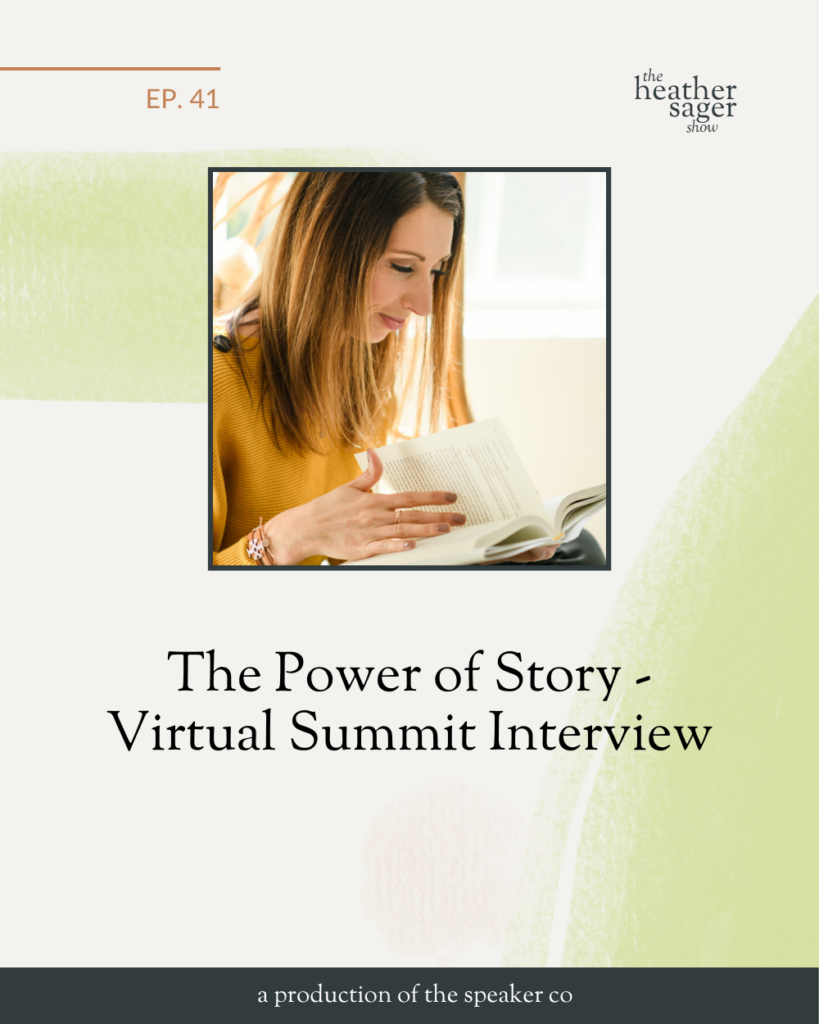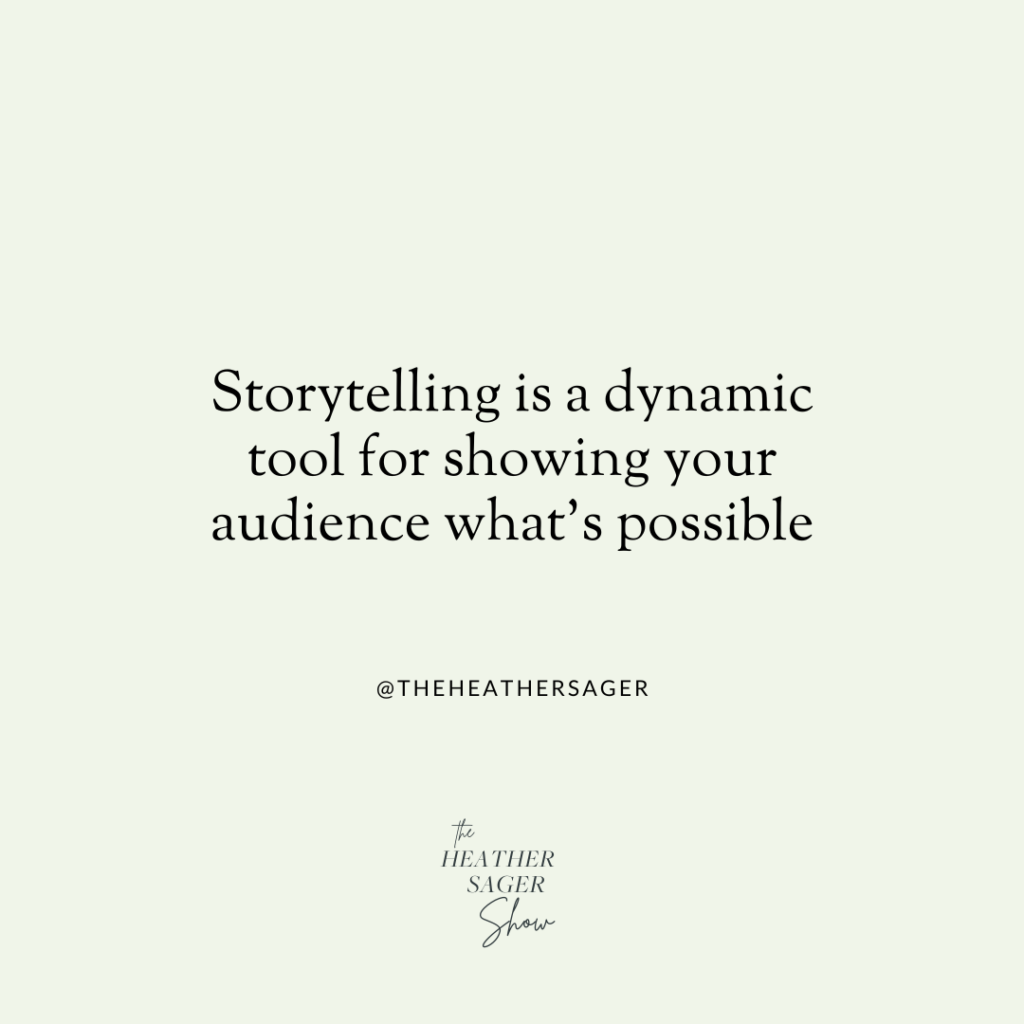
LISTEN TO THIS EPISODE ON APPLE PODCASTS / SPOTIFY / STITCHER
You already know you should tell more stories. What you might not know is telling them isn’t enough. This week I’m sharing with you my interview in the Power of Story virtual summit about the art of strategic storytelling and what you need to know to deliver stories in a compelling way.
In this interview with Adrienne Dyer, I share:
- What exactly is strategic storytelling
- How to place stories at the right times in your content
- The biggest mistakes made when telling stories in business (and how to avoid them)
- Beyond the stories, what you need to know about delivering your message
I encourage you to not only take notes on the storytelling strategies in this episode, but since I’m also in an interview format (ie., on a stage), take note on HOW I show up and deliver my content. This is another chance for you to see me model my speaking strategies in real (erm virtual) life.
Episode Show Notes
On my start to storytelling in business
(11:41) I learned that storytelling was an incredible strategy for helping people see how different best practices and different content can actually play out in their daily lives when maybe on face value, they didn’t see how that curriculum would really apply to them. I found that storytelling was effective not only for getting attention, but it also was a really powerful tool for persuasion to gain buy-in with the people that I was teaching.
On being uncomfortable in front of camera
(13:48) I think what happens is maybe we’re not even aware of that, but that’s what’s really happening is we’re not sure how to communicate fully. I think we get a little afraid of ourselves on camera. There’s something about a video camera knowing that like if I were to look down here, I can see myself and if I wasn’t used to seeing myself as most of us aren’t. It can be a little jarring because you don’t see yourself all day long, but other people do. There’s that piece, the idea that it’s recorded and you capture it back. It’s uncomfortable and we have a tendency to shy away from uncomfortable things.

Importance of video in the online community
(14:24) In this world where we’re online building relationships and building trust with prospects and our audience all the time, video is such an accelerant to trust. It’s worth the discomfort because you get through that discomfort pretty quickly if you’re willing to push.
The biggest challenge for writers when speaking live
(15:00) It’s really hard when you’re a writer and how you have all the time in the world to perfectly craft the words. Before they’re seen by anybody, you can make sure that you’re absolutely happy with the words. When you’re speaking live, you’ve got to think off the top of your head. You worry about saying something stupid, or stumbling, or just completely losing your train of thought.
How do you think on your feet all the time?
(15:41) I’m really good at thinking on my feet, but it’s because of 15 years of training. For me, I practice so much. Here’s what you have to practice… You have to learn how to train that connection between your mind and your mouth.
How word vomit or saying thoughts out loud helps in building your confidence?
(17:19) This idea that the more that you word vomit, the more confident you get that the next time somebody asks you a question similarly, or you have to pitch or do something, it’s not the first time you’re doing it. It’s just in that moment it feels impromptu.
But trust me, any professional speaker, they feel so off the cuff but it’s because of years and years of practice. Getting their vocabulary down, getting their stream between their thoughts and their words, how they practice those things so in the moment comes, they know how to string words together that sound really well put together. They’re strategic. There is an element of spontaneity to it, but it’s because of the training we’ve done.
Mistake that people make when it comes to telling stories
(19:41) Here’s what happens is most people make the mistake of, they go, ‘Okay, I get it. I need to tell a story to drive connection’. They miss an important piece, and that’s when you tell stories at the right times.
How to place stories at the right times
(21:27) You tell a story right before an important piece of content to capture and peak their attention, so that way you have the room in the palm of your hands to then deliver a really important piece of information. There’s a common marketing term where you say like ‘hook, ‘then you deliver your content.
Story arc vs little stories?
(22:49) I think you can approach it a couple of different ways…I don’t think there’s a right or wrong way to do it. I think what you have to focus on is are you using your story for the benefit of your audience or are you just telling it because you think it sounds good and it was a crazy life event that happened to you.
Biggest mistake people make when it comes to storytelling
(27:27) I think the mistake people make is they just tell stories cause they think they’re good stories. You have to think about what emotions, what shared connections do you have with your audience, what kind of details could you share that are not too detailed, where you paint the picture so much for them. You have to stem visualization in their mind.
How to make your stories so good?
(30:34) communication is far more dynamic than words. I think a thing that would be really powerful for people to think about is how do you tell stories? A thing that makes this story so good isn’t just the words you use, but there’s an experience you create. There’s feelings that you evoke with your audience.
Using hand gestures in building audience’s trust
(36:18) There was a really incredible study done by the Science of People. It’s a company run by Vanessa Van Edwards. She’s really famous. She’s got a great Ted Talk online..the Ted talks that had more hand gestures, had higher watch rates…People were far more interesting and far more engaged when they have hand gestures. She also talks about a study that shows that when people can see your hands they are more trusting.
What’s the best way to connect with other people?
(48:29) If you think about your role as a content creator, as a speaker, as a writer, whatever it is that you do, the best way for you to connect with other people is to figure out how to help them feel heard. The backward way as you think the way for them to feel heard is by them talking. A lot of times people just need to see through you that they’re not alone.
Links mentioned in episode:
Show Up with Confidence on Camera – Conquering Fear & Creating Engaging Video Content – Ep #38